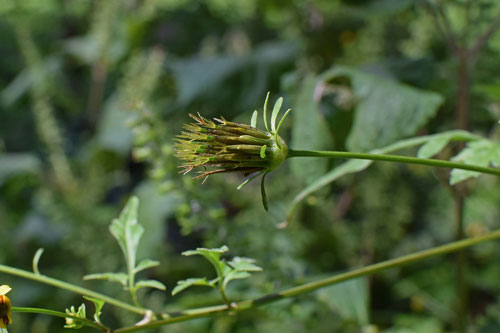
Primavera by Sandro Botticelli, circa 1482
Spring conjures images of life renewed, flowery blooms, love and mating. But for one in five people, it means shutting the windows, missed days at work, and the annual pilgrimage to the local pharmacy to pick up allergy medications, antihistamines, decongestants, combination allergy medicines, and anti-inflammatory medications all with a list of possible adverse reactions, precautions and contraindications. The fact that none offers a cure but only relief is of no matter, because when allergies strike it is relief that is so desperately sought.
Common Ragweed, Ambrosia artemisiifolia
If it is relief that you are after, there is an herb that, for many, effectively relieves hay fever-like allergy symptoms within 15 minutes after ingesting. Believe it or not, it happens to be the highly invasive weed, ragweed (Ambrosia artemisiifolia et spp.). Ragweed is ubiquitous in most parts of the country and ironically is itself responsible for 90% of pollen-induced allergies in the United States. Ragweed is also commonly known as ambrosia or bursage. Ragweed is a member of the Asteraceae family, noted for plants that cause allergic reactions in many. Ragweed is the probably the worst and most notorious of all pollen-caused allergies. In fact, with global warming, there is an increase of pollen generated and a concomitant increase in the prevalence and severity of respiratory allergies.
The great founder of 18th century homeopathy, Samuel Hahnemann (1755-1843), would love ragweed because it lends proof to a fundamental homeopathic principle, which is “like cures like.” While inhaling ragweed pollen causes mild to severe reactions in those who are sensitive, ingesting 5 to 15 drops of a 5:1 strength herbal extract made from the pre-flowering dried leaves relieves hay fever-like symptoms, not only to ragweed pollen but to all tree pollens, cat and dog dander, mites and mold.
The “like treats like” principle has some possible scientific support. In an attempt to find an easier, more efficient and hopefully cheaper alternative to weekly allergy shots, Dr David Skoner of Allegheny General Hospital discovered that putting liquid drops or a rapidly dissolving tablet of an allergen under the tongue controlled Ragweed allergies enough to negate the need for weekly appointments for allergy shots. He posits that the allergens under the tongue travel directly to lymph nodes where the immune system makes the anti-allergen response to lessen sensitivity, “just like the shots did.” Said Dr. Skoner. This was recently reported in Pittsburgh based WTAE Action News on February 28, 2013.
Santa Cruz County, Calif., happens to be rife with a number of allergy causing pollens, chief of which is from the invasive Acacia tree species. As we age, our immune system eventually wears down; in my case, I notice more that my eyes are more frequently itchy, attested to by the number of OTC eye drops I’ve collected. My friend and colleague Ben Zappin introduced me to some of his ambrosia tincture. He said it is also extremely effective against cat dander. Having two cats and two members of my family who don’t feel it is safe to visit because of cat allergies, I decided to give ambrosia a try. It only took 30 drops of the extract to provide within 15 minutes, complete symptomatic relief for an entire day. I now use it on an as needed basis.
How do we know about ragweed’s actions on allergies? In fact very little is known either scientifically or by herbalists about the use of Ragweed for hay fever. It is not mentioned in any of the many herbal texts that I have dating back to the 19th century with the exception of William Cooke’s Physio-Medical Dispensatory where it is described as a stimulating astringent for dysentery, leucorrhea, periodic fevers, and other abnormal discharges with no mention of its use for hay fever symptoms.
In his book Medicinal Plants of the Pacific West, the late herbalist Michael Moore, who personally was close to the traditional Central American native uses of medicinal herbs, describes a standard one- to two-ounce infusion of the flowering herb used for head colds, allergies and moderate histamine reactions.
A more extensive discussion is in herbalist Mathew Wood’s Earthwise Herbal. Wood makes the distinction between allergic symptoms to goldenrod (Solidago spp.) and ragweed and describes how a “nip of the leaf, taken at the time of the allergy, will almost always abort such an (allergic) attack,” with characteristic symptoms of “sneezing, runny nose, bloodshot eyes, swollen capillaries in the eyes, itching of nose and eyes, and in long-term reactions of bronchial congestion.” He offers an energetic description: bitter, pungent and slightly astringent. Wood recommends that the fresh leaves fresh be tinctured 1:2 in 95% alcohol watered down to 70%. He recommends giving only one drop initially to determine sensitivity. If there is no adverse reaction or an improvement in symptoms, five to 10 drops be given every two to three hours as recommended by the early 20th-century Eclectic herbalist John William Fyfe or 15-20 drops by the contemporary herbalist 7Song.
Herbalist Susun Weed writes in her blog post on ragweed: “The (H)ungarian author (Weixl-Várhegyi László) claims that the he harvests the young plants early, while they are small and eats the plant leaves raw and also dries the rest and makes a powder from it to preserve it for later use for culinary purposes.” This author claimed to receive this information from a pastor in 1973. Weed also mentions an online discussion where participants shared their personal experiences consuming ragweed tincture and tea with promising results.
I found an interesting reference to it on the Pacific School of Herbal Medicine’s Clinical Tidbits page. There it is stated how it is “well known to herbalists, both mainstream and Californian Native/Hispanic.” The article describes how it slows “copious fluid discharge from the eyes and nose usually within fifteen minutes.”
Why “Ambrosia?”
Why is this herb, generally considered noxious and invasive, given the name “Ambrosia,” a name whose Greco-roman origins means “food of the gods?” No one seems to know for sure, but a little known fact offers a clue. It seems that giant ragweed (A. trifida) is a highly nutritious and edible plant suitable for human consumption. The seeds of giant ragweed are 47% crude protein, much higher than any cultivated grain. Furthermore, the plants produce a prodigious amount of seed. According to Roger Wells, a certified wildlife biologist and national habitat coordinator for Quails Unlimited, the seeds contain “the highest amount of metabolizable calories, more even than corn, soybeans, wheat, or any other grain that we know.” Giant ragweed is native to America and has excellent soil-binding qualities. Based on studies in Kentucky of archeological sites, it was cultivated and nurtured some 2,000 years ago for its nutritional seeds by Native American people living in the Mississippi Valley. Perhaps the name “Ambrosia” may refer to these highly nutritious properties of giant ragweed.
How to Make a Ragweed Tincture
With spring being just a few weeks away, many of you may want to make your own Ambrosia tincture. Following is a recipe I found and intend to follow with my initial explorations using this herb:
- Trim several flowering tops off the ragweed plants and pack them tightly into a wide mouthed glass jar.
- Fill the jar with the highest proof vodka or liquor you can obtain such as Everclear.
- Label the jar with the date and name of the tincture using a marker and scotch tape.
- Store the jar with ragweed and vodka in a cool, dark place for six weeks.
- Strain and bottle for use.
The above is adapted from Making a Ragweed Tincture.


Ok….After the tincture sits for 6 weeks and you strain it. Do you mix it with distilled water 2:1 and then give drops? Or what do you do to water it down. How long do you have to take it. Thanks Jim